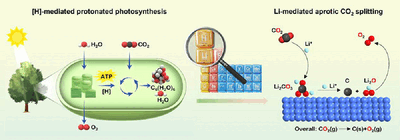Direct splitting: electrochemical process uses carbon dioxide to produce oxygen
To mitigate global climate change, emissions of the primary culprit, carbon
dioxide, must be drastically reduced. A newly
developed process helps solve this problem: CO2 is directly split
electrochemically into carbon and oxygen. As a Chinese
research team reports in the journal Angewandte Chemie, oxygen
could also be produced in this way under water or in space—without
requiring stringent conditions such as pressure and temperature.

© Wiley-VCH, re-use with credit to 'Angewandte Chemie' and a link to the original article.
Leafy plants are masters of the art of carbon neutrality:
during photosynthesis, they convert CO2 into oxygen and
glucose. Hydrogen atoms play an important role as “mediators”. However,
the process is not particularly efficient. In addition, the oxygen
produced does not come from the CO2 but from the absorbed
water. True splitting of CO2 is not taking place in plants
and also could not be achieved at moderate temperatures by technical
means so far.
Ping He, Haoshen Zhou, and their team at Nanjing University, in
collaboration with researcher from Fudan University (Shanghai) have
now achieved their goal to directly split CO2 into elemental
carbon and oxygen. Instead of hydrogen, the “mediator” in their method
is lithium. The team developed an electrochemical device consisting of a
gas cathode with a nanoscale cocatalyst made of ruthenium and cobalt
(RuCo) as well as a metallic lithium anode. CO2 is fed into
the cathode and undergoes a two-step electrochemical reduction with
lithium. Initially, lithium carbonate Li2CO3 is
formed, which reacts further to produce lithium oxide Li2O
and elemental carbon. In an electrocatalytic oxidation process, the Li2O
is then converted to lithium ions and oxygen gas O2. Use of
an optimized RuCo catalyst allows for a very high yield of O2,
over 98.6 %, significantly exceeding the efficiency of natural
photosynthesis. As well as pure CO2, successful tests were
also carried out with mixed gases containing varying fractions of CO2,
including simulated flue gas, a CO2/O2 mixture,
and simulated Mars gas. The atmosphere on Mars consists primarily of CO2,
though the pressure is less than 1 % of the pressure of Earth’s
atmosphere. The simulated Mars atmosphere thus contained a mixture of
argon and 1 % CO2.
If the required power comes from renewable energy, this
method paves the way toward carbon neutrality. At the same time, it is a
practical, controllable method for the production of O2 from
CO2 with broad application potential—from the exploration of
Mars and oxygen supply for spacesuits to underwater life support,
breathing masks, indoor air purification, and industrial waste treatment.
(2677 characters)
About the Author
Dr. Ping He is a Professor and Head of the Department of
Energy Science and Engineering at the College of Engineering and Applied
Sciences, Nanjing University. His research interests focus on
transformative electrochemical energy technologies, including
high-energy-density batteries, electrochemical CO₂ reduction, and
lithium resource extraction and recycling. He is a Fellow of the Royal
Society of Chemistry and serves as an Associate Editor for ACS Energy &
Fuels.
Copy free of charge—we would appreciate a transcript/link of your
article. The original articles that our press releases are based on can
be found in our online pressroom.